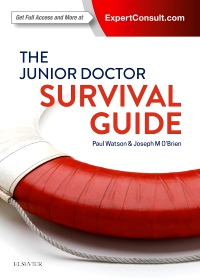
The Junior Doctor Survival Guide - E-Book, 1st Edition
Elsevier eBook on VitalSource

-
- Scenario boxes – how difficult conversations should be approached
- Common medications – quick reference tables of common medications and dosages
- Clinical abbreviations and acronyms – a comprehensive list of common abbreviations and acronyms used throughout clinical settings
-
Section I: General information
Chapter 1: Welcome to medical practice
Chapter 2: The junior doctor
Chapter 3: Careers
Chapter 4: Professionalism
Chapter 5: Communication
Chapter 6: Teaching and education
Chapter 7: Representation of Junior Doctors
Chapter 8: FinancesSection II: Initial Assessments
Chapter 9: The emergency department
Chapter 10: Critical care assessments
Chapter 11: Initial assessment of patients: history and examination
Chapter 12: Investigations: serology
Chapter 13: Investigations: other pathology
Chapter 14: Investigations: imaging
Chapter 15: Making referrals
Chapter 16: Admissions
Chapter 17: Clinical procedures
Chapter 18: The patient with mental illness
Chapter 19: Forensic medicine
Chapter 20: Notifiable diseasesSection III: The Ward
Chapter 21: The inpatient ward
Chapter 22: Ward rounds
Chapter 23: Inpatient prescribing
Chapter 24: Managing fluids and infusions
Chapter 26: The dying patient
Chapter 27: The deceased patient
Chapter 28: The preoperative patient
Chapter 29: The operating theatre
Chapter 30: The postoperative patient
Chapter 31: Inpatient discharges
Chapter 32: Allied health and clinical support staff
Chapter 33: Unit meetingsSection IV: Medical and surgical specialties
Chapter 34: General medicine
Chapter 35: Cardiology
Chapter 36: Respiratory medicine
Chapter 37: Gastroenterology
Chapter 38: Renal medicine
Chapter 39: Endocrinology
Chapter 40: Neurology
Chapter 41: Infectious Diseases
Chapter 42: Medical oncology
Chapter 43: Haematology
Chapter 44: Rheumatology
Chapter 45: General Surgery
Chapter 46: Orthopaedic Surgery
Chapter 47: Vascular Surgery
Chapter 48: Cardiothoracic Surgery
Chapter 49: Ear, nose and throat (ENT) and head and neck surgery
Chapter 50: Neurosurgery
Chapter 51: Plastic and reconstructive surgery
Chapter 52: UrologySection V: Outpatients
Chapter 53: Pre-admission clinic
Chapter 54: Informed Consent
Chapter 55: Medical outpatient clinics
Chapter 56: Cardiology outpatients
Chapter 57: Respiratory outpatients
Chapter 58: Gastroenterology outpatients
Chapter 59: Renal outpatients
Chapter 60: Endocrine outpatients
Chapter 61: Neurology outpatients
Chapter 62: Medical oncology outpatients
Chapter 63: Haematology outpatients
Chapter 64: Rheumatology outpatients
Chapter 65: Surgical clinics
Chapter 66: General Surgery outpatients
Chapter 67: Orthopaedic outpatients
Chapter 68: Vascular outpatients
Chapter 69: Cardiothoracic outpatients
Chapter 70: Ear, nose and throat and head and neck outpatients
Chapter 71: Neurosurgery outpatients
Chapter 72: Plastic and reconstructive surgery outpatients
Chapter 73: Urology outpatientsSection VI: Appendices
Appendix I: Common Medications
Appendix II: Normal Lab values
Appendix III: Microbiology
Appendix IV: Antibiotics

 as described in our
as described in our 